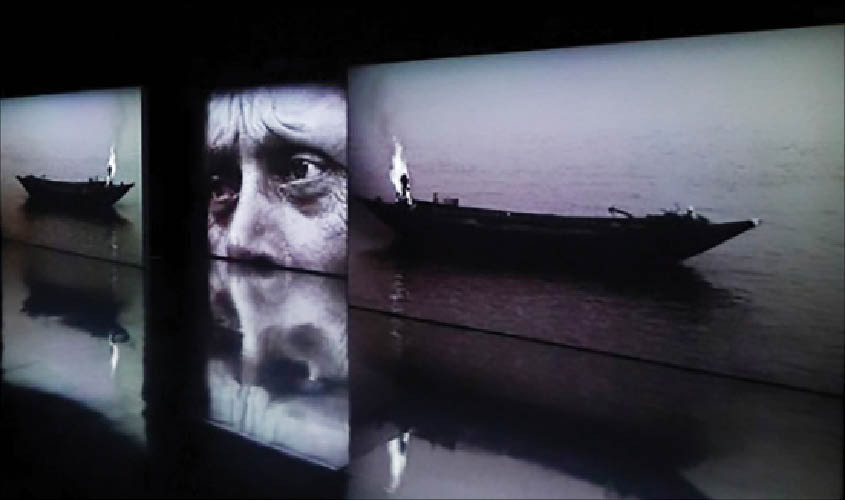Ranbir Kaleka’s new show, entitled Fear of a New Dawn, features multimedia works that are surreal yet deeply rooted in the crises and predicaments of contemporary reality. He looks at the present without forgetting the past, writes Bhumika Popli.
Ranbir Kaleka’s latest exhibition, Fear of a New Dawn, is now on view at Delhi’s Vadehra Art Gallery and it features only five multimedia works, which paint a bleak image of contemporary society. While his approach is nuanced, the artworks still manage to make a strong emotional impact on viewers.
Take for example House of Opaque Water, a three-channel projection the artist made with environmentalist Pradip Saha. The video looks at the effects of global warming and the rising water levels in the Sunderbans which have drowned several nearby islands, once home to many people.
In the video, a man is seen rowing a boat. He says, “This is my home…our cows grazed by the Banayan tree.” But neither a house nor any cow is visible in the video. There is only a vast expanse of water. Once this was site of the man’s home, an island that now lies inundated under the water.

The video also features Kaleka and Saha. “This is probably the second time I have included myself in my videos,” Kaleka tells Guardian 20. “In this work, it made more sense. I wanted to show how the work began. As the video progresses, it goes into a kind of feverish dream. There is a sense of loss. There is a setting sun in the video. But as the sun is not dead when it sets and it goes somewhere else, so it is not like there is only bleakness. Darkness too has potential. You can create things out of the darkness whereas light gives you what there is. You can’t do anything with light.”
The artist addresses social issues in his work. Bound, another video projected on burnt wood, which is part of this exhibition, is about farmers’ plight, another form of darkness.
The video features a blurry figure of a man lying on the ground. Occasionally, this figure quivers. Then it goes motionless again. It is visited by animals, birds and humans at different points in the video. Everything is blurry. “The video is blurred and unclear because I wanted to show uncertainty in the life of farmers. They are not able to understand what exactly is causing them trouble. One feels helpless after reading about their situation in newspapers. They are bound to the earth, to their land in such a way that now the earth itself has become a coffin for them,” says Kaleka.
Kaleka’s works are not noisy. No one is shouting slogans. The sounds are aptly used whenever required. And then there is his use of the black-and-white format, which adds to the sombre tone of the exhibition. Despite all this, the works are “loud” enough to speak to you about the critical issues facing our world today.

Most of his themes are dystopian but without being distressing. His multimedia work Not Anonymous_Waking to the Fear of a New Dawn is projected through multiple feeds. In one, a man whose head is literally shown in the clouds, is hitting arrows. In another, one more man, presumably the former’s victim, is partially visible. Every time an arrow hits its target, the donkey displayed in an adjacent video feed starts bleeding. For Kaleka, donkeys have played an important role in the building of civilisations—by assisting human beings in transporting people and goods. Yet the artist’s metaphor of civilisational demise through the bleeding of the donkey doesn’t appear gory, because of the black-and-white format.
Two more works by the artist are on the same format. The multimedia work Fearsome Acquiescence of a Monotonous Life, and the digital collage painting The Unremarkable Life of the Man with Tiffin are sombre but can still jolt the viewer. The artist’s intent here, too, is to draw our attention to the theme of civilisational decline.
“In Fearsome… I wanted to combine the past and present and for this reason, moving images interest me to a large extent,” he says.
The Unremarkable Life of the Man with Tiffin is a digital painting, with multiple images in the background of a large figure which dominates the artwork. Among these, the one which deeply intrigues is that of a huge cloud that signifies fire and smoke—probably representing a blast of some kind. In the foreground of the painting, people are going about their usual chores indifferent to the fireball behind them—the contrast is shocking.
Fear of a New Dawn is on view till 6 April at Delhi’s Vadehra Art Gallery

